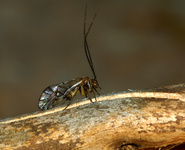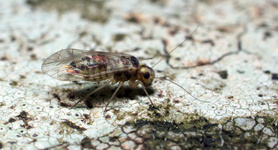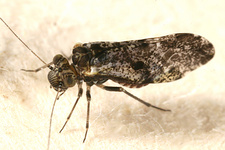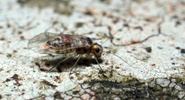Psocidae
Bark Lice
Emilie Bess and Kevin P. Johnson


This tree diagram shows the relationships between several groups of organisms.
The root of the current tree connects the organisms featured in this tree to their containing group and the rest of the Tree of Life. The basal branching point in the tree represents the ancestor of the other groups in the tree. This ancestor diversified over time into several descendent subgroups, which are represented as internal nodes and terminal taxa to the right.

You can click on the root to travel down the Tree of Life all the way to the root of all Life, and you can click on the names of descendent subgroups to travel up the Tree of Life all the way to individual species.
For more information on ToL tree formatting, please see Interpreting the Tree or Classification. To learn more about phylogenetic trees, please visit our Phylogenetic Biology pages.
close boxIntroduction
The family Psocidae is the largest family of Psocodea, containing over 80 genera and over 900 described species worldwide. These are small to large-sized bark lice (2-12 mm) with diverse morphology. Most species live on bark, but a few are ground-dwelling. Psocidae includes the largest species of bark louse, in the South American genus Thyrsophorus.
Psocidae contains two subfamilies, Psocinae and Amphigerontiinae, both distributed worldwide.
Characteristics
Synapomorphies
- Abdomen: Presence of an articulation between hypandrium and clunium.
- Female: Presence of the posterior lobe of the external valve of the gonapophyses.
General Characters
- Head: Antennae have 13 segments.
- Legs: Tarsi have 2 segments.
- Wings:
- Forewings nearly always hairless; hairs are sparse and small if present.
- Forewing veins:
- Cubital loop is always joined to vein M for a distance.
- Vein M has three branches.
- Aerola postica is joined to vein M (vein Cu1A fused with vein M).
- Hindwing is nearly always hairless except for few hairs between veins R2+3 and R4+5.
- Male:
- Paraprocts have strongly developed clasper-like processes.
- Hypandrium is ornamented variety of forms: teeth, hooks, spines, grooves, ridges and tubercles – symmetrical or not.
- Phallosome is usually a fairly simple structure with a closed frame.
- Males of subfamily Amphigerontiinae have heavily sclerotised anterior abdomen.
- Female:
- Subgenital plate usually has a single well-developed lobe.
- Gonapophyses are complete and well developed:
- Ventral valve is pointed.
- Dorsal valve is broader than the ventral valve, usually ‘fleshy’ in appearance and apically pointed or rounded.
- External valve is large, well developed and hairy.
- Eggs: Eggs are laid single or in groups and covered with encrustation and occasionally, also with silk.
How to Know the Family
- Among the largest bark lice, medium to large bodies (5-8 mm), often appear "chunky" with long legs.
- Most adults have full wings.
- Eyes sometimes very large and spherical, especially in males.
- Hairs on body and wings minimal or absent.
- Tarsi have 2 segments.
- Forewing vein M has 3 branches.
- Forewing areola postica is joined to vein M.
- Forewing vein Cu1A is joined to vein M.
- Hindwing veins Rs and M are fused for a short length.
- Male genitalia often heavily ornamented with teeth, spines, etc, and highly variable.
- Males of subfamily Amphigerontiinae have heavily sclerotised anterior abdomen.
Family Monophyly
The monophyly of Psocidae is supported by both molecular and morphological data. Morphological data support the monophyly of Psocidae based on the presence of an articulation between the hypandrium and clunium, and the presence of the posterior lobe of the external valve of the gonapophyses (Yoshizawa 2002). In a molecular analysis that included three genera from subfamily Psocinae (Loesnia, Metylophorus, and Trichadenotecnum) and one genus from subfamily Amphigerontiinae (Blastopsocus) with a data set that combined 18S rDNA, and 12S, 16S, COI rDNA, Johnson and Mockford (2003) found Psocidae to be monophyletic.
Discussion of Phylogenetic Relationships
Psocidae currently contains two subfamilies: Psocinae (includes 6 tribes) and Amphigerontiinae (possibly paraphyletic, includes 4 tribes). Morphological and molecular data generally agree on subfamily relationships, although relationships within the largest tribe, Ptyctini, are not well resolved (Yoshizawa and Johnson 2008).
References
Johnson, K. P. & E. L. Mockford. 2003. Molecular Systematics of Psocomorpha (Psocoptera). Systematic Entomology 28: 409-40.
Lienhard, C. and C. N Smithers. 2002. Psocoptera (Insecta) World Catalogue and Bibliography. Muséum d'Histoire Naturelle, Geneva, Switzerland.
Mockford, E. L. 1993. North American Psocoptera (Insecta). Gainesville, Florida: Sandhill Crane Press,
New, T.R. 2005. Psocids, Psocoptera (Booklice and barklice), 2nd edition: Handbooks for the Identification of British Insects. Vol. 1, Part 7. Royal Entomological Society, London, UK.
Smithers, C. N. 1996. Psocoptera. Pp. 1-80, 363-372 (Index) in Wells A. (ed.) Zoological Catalogue of Australia. Vol. 26. Psocoptera, Phthiraptera, Thysanoptera. Melbourne: CSIRO Publishing, Australia.
Yoshizawa, K. 2002. Phylogeny and higher classification of suborder Psocomorpha (Insecta: Psocodea:'Psocoptera'). Zoological Journal of the Linnean Society 136: 371-400.
Yoshizawa, K. and Johnson, K.P. 2008. Molecular systematics of the barklouse family Psocidae (Insecta: Psocidae: 'Psocoptera') and implications for morphological and behavioral evolution. Molecular Phylogenetics and Evolution 46: 547-559.
Information on the Internet
- Psoco Net: The Psocidologists' Home Page. The latest information on Psocoptera taxonomy and reserchers in the Psocoptera community, maintained by Dr. Kazunori Yoshizawa, Hokkaido University, Sapporo, Japan.
- Discover Life: Psocoptera Page
- Dr. Charles Lienhard. Psocid expert at the Natural History Museum, Geneva, Switzerland.
- Dr. Edward Mockford. Expert on Psocids of North America and beyond, Illinois State University.
- Dr. Kevin Johnson. Expert on molecular systematics of Psocids and parasitic lice, Illinois Natural History Survey.
- Emilie Bess. Research on Psocids of Hawaii and elsewhere, University of Illinois.
Title Illustrations

| Scientific Name | Psococerastis sp. |
|---|---|
| Location | Nokonoshima Island, Kyushu, Japan |
| Specimen Condition | Live Specimen |
| Identified By | K. Yoshizawa |
| Sex | Male |
| Life Cycle Stage | adult |
| View | dorsal |
| Size | 4mm |
| Copyright | © 2006 Kazunori Yoshizawa |
| Scientific Name | Blaste sp. |
|---|---|
| Location | Nokonoshima Island, Kyushu, Japan |
| Specimen Condition | Live Specimen |
| Identified By | K. Yoshizawa |
| Life Cycle Stage | adult |
| View | dorsal |
| Size | 3mm |
| Copyright | © 2006 Kazunori Yoshizawa |
| Scientific Name | Loensia moesta |
|---|---|
| Location | Groton, Ma. |
| Comments | 9/16/2007 |
| Specimen Condition | Live Specimen |
| Life Cycle Stage | adult |
| View | lateral |
| Copyright | © Tom Murray |
About This Page
Emilie Bess

Illinois Natural History Survey, Champaign, Illinois, USA
Kevin P. Johnson

Illinois Natural History Survey, Champaign, Illinois, USA
Correspondence regarding this page should be directed to Emilie Bess at and Kevin P. Johnson at
Page copyright © 2009 Emilie Bess and Kevin P. Johnson
All Rights Reserved.
- First online 11 October 2006
- Content changed 25 March 2009
Citing this page:
Bess, Emilie and Kevin P. Johnson. 2009. Psocidae. Bark Lice. Version 25 March 2009 (under construction). http://tolweb.org/Psocidae/14482/2009.03.25 in The Tree of Life Web Project, http://tolweb.org/











 Go to quick links
Go to quick search
Go to navigation for this section of the ToL site
Go to detailed links for the ToL site
Go to quick links
Go to quick search
Go to navigation for this section of the ToL site
Go to detailed links for the ToL site